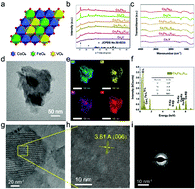Modulated transition metal–oxygen covalency in the octahedral sites of CoFe layered double hydroxides with vanadium doping leading to highly efficient electrocatalysts†
Abstract
The development of efficient and stable non-noble-metal electrocatalytic materials for the oxygen evolution reaction (OER) is a huge and important challenge at present. Herein, we report the prominent enhancement of OER activity via doping vanadium into CoFe-based layered double hydroxide (LDH) electrocatalysts. Electrochemical characterization shows that the Co2Fe0.5V0.5 LDH grown on carbon papers (CPs) has an enormous electrochemical surface area (ECSA) and exhibits the smallest overpotential of 242 mV at 10 mA cm−2, which only requires a small Tafel slope of 41.4 mV dec−1 in 1 M KOH solution. The X-ray photoelectron spectroscopy (XPS) peak position of Co, Fe and O moves slightly to higher binding energy, elucidating the improved covalency of the metal–oxygen bond after V doping. DFT+U simulation indicates that the outstanding electrocatalytic activity of Co2Fe0.5V0.5 could be ascribed to the increased metal–oxygen covalency in LDH after V element doping, and facilitates the charge-transfer from oxygen to the metal. This finely tuned strategy by V doping into the CoFe-based LDH matrix can adjust the covalency of metal–oxygen bridges and enhance its electrocatalytic activity for the OER. In this work, we also present a general method to study various highly efficient metal hydroxide catalysts for the OER.



 Please wait while we load your content...
Please wait while we load your content...